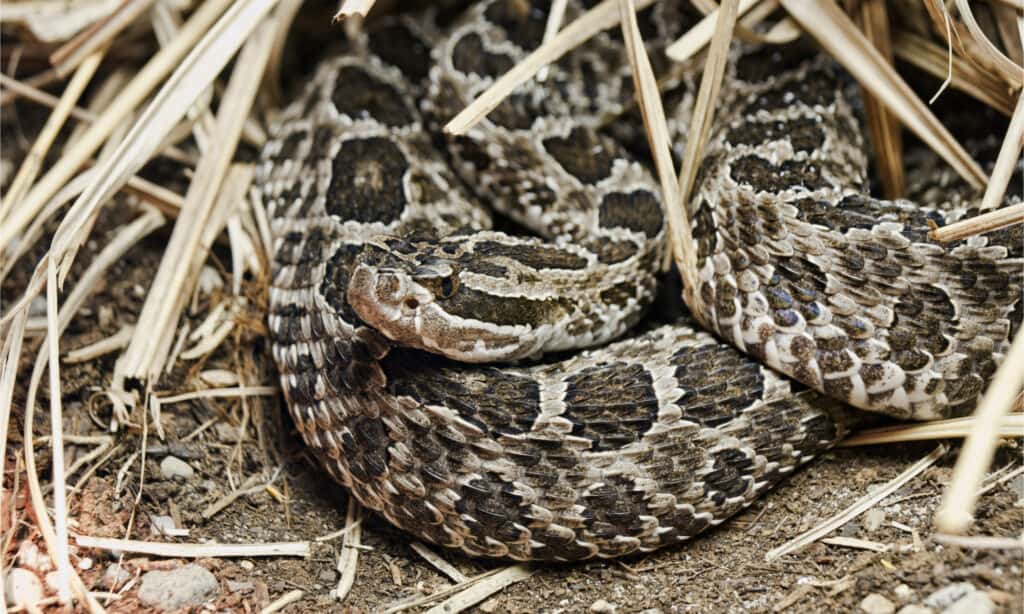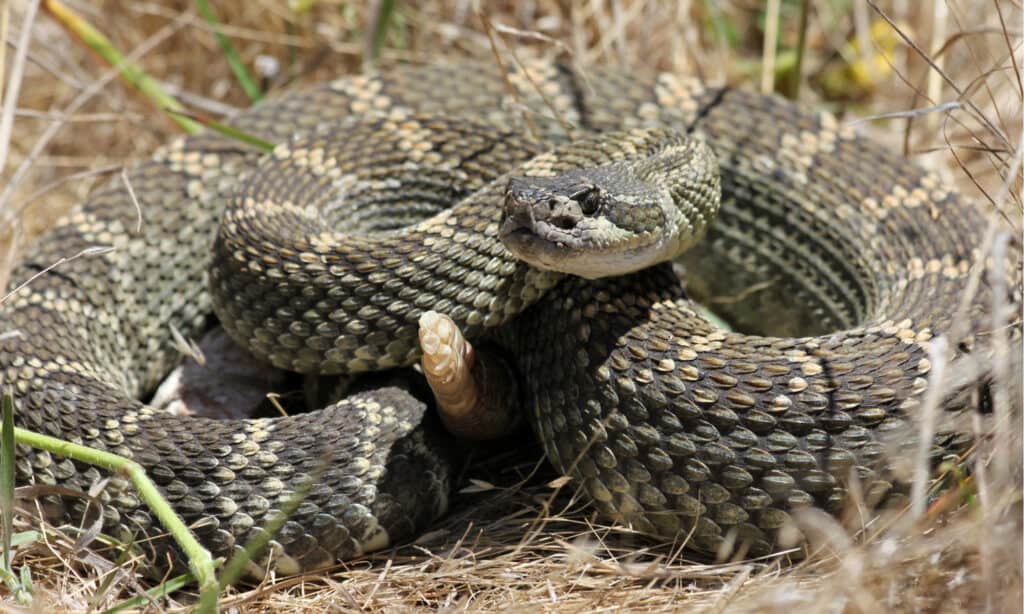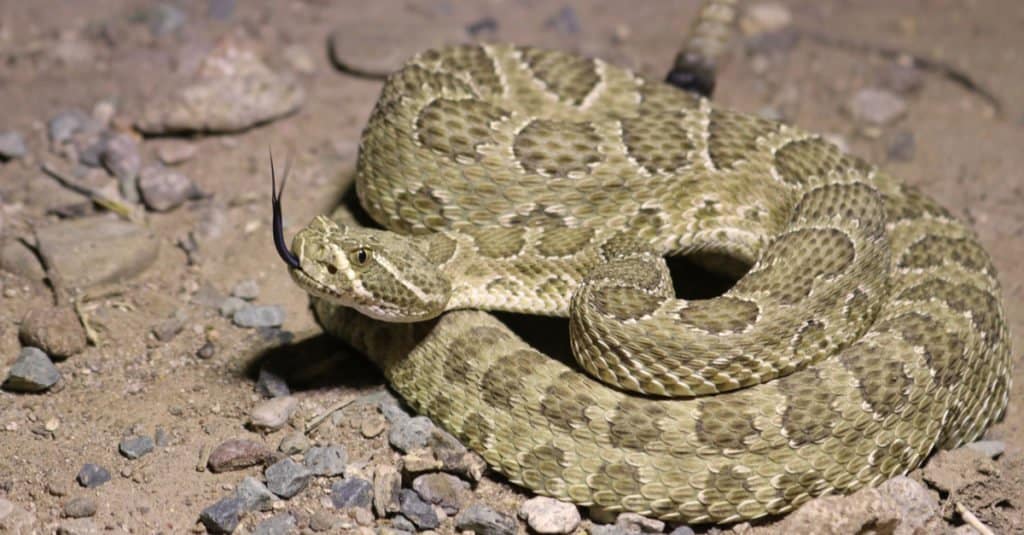As one of the largest countries in the world, it’s not surprising that Canada has a wide variety of animals that call it their home. From polar bears and grizzly bears to the mighty wood bison, there are certainly some large dangerous animals in the country, but what about the smaller ones? There are three venomous snakes in Canada, but which one is the most dangerous? Read on to discover the deadliest snake in Canada!

What Is the Deadliest Snake in Canada?
The deadliest snake in Canada is the eastern massasauga rattlesnake. It possesses cytotoxic venom which affects the tissue by causing necrosis (tissue death). A bite can result in extensive scarring of the affected area and even limb amputation in humans.
The deadliest snake in Canada is the eastern massasauga rattlesnake. There are only three reported deaths from a venomous snake in Canada. Two of these were caused by an eastern massasauga rattlesnake, making it the deadliest snake in the country. However, it should be noted that these bites occurred when the snakes were stepped on and the snakes were acting in a defensive manner.
Eastern massasaugas are not typically aggressive snakes but they can become defensive if they are threatened. Eastern massasaugas possess cytotoxic venom which affects the tissue by causing necrosis (tissue death). Although not typically as deadly as hemotoxic or neurotoxic venom, it does often result in extensive scarring of the affected area and even amputation of the limb.

Eastern massasaugas are responsible for the most deaths from venomous snakes in Canada.
©Vladislav T. Jirousek/Shutterstock.com
If you are bitten by an eastern massasauga then the most important thing to do is to seek medical treatment immediately. Although initially the symptoms may present as extreme pain and swelling they can quickly become worse without treatment. For the best results, anti-venom should be administered within two hours of the bite occurring.
What Do Eastern Massasaugas Look Like?

Eastern massasauga
rattlesnakes
have light brown bodies with large brown blotches down their backs and smaller ones on their sides.
©DnDavis/Shutterstock.com
Eastern massasaugas are medium-sized snakes that range between 24 and 30 inches long. They are typically tan or grey with large dark brown or black blotches down the middle of their back. They also have three rows of smaller blotches on their sides. However, in some cases, they may be almost entirely black or have particularly large blotches that touch each other and form large, dark markings. As pit vipers, eastern massasaugas also have two heat-sensing pits on their head.
Juveniles have a similar appearance to adults, although they often have a paler color, especially on their ground color. The breeding period usually occurs between July and August. However, the females store the sperm inside them and do not give birth until the following year. Eastern massasaugas are ovoviviparous. This means that they retain their eggs inside them until they hatch, then give birth to live young. The juvenile snakes are only seven to 10 inches long when they are born and litters can consist of between five and 20 young snakes.
Eastern massasaugas prey on a variety of mammals, birds, reptiles, and amphibians. However, the juveniles tend to prey on smaller reptiles and insects.
Where Do Eastern Massasaugas Live?
Eastern massasaugas can live in a variety of habitats. However, they are commonly associated with wetland habitats, such as swamps, wet meadows and prairies, and the edge of rivers and lakes. In Canada, they live only in Ontario where they have a very limited range. Small populations exist along the eastern shore of Georgian Bay, parts of the Bruce Peninsula, Niagara Peninsula, and near Windsor.
As we mentioned earlier, most bites from these snakes occur when they are accidentally stepped on. Therefore, it’s important to take care and watch where you are treading if you are within their range. You should always pay particular attention around any rocks or fallen logs as they may harbor a snake underneath them. Additionally, you should also never put your hands into an enclosed area where you cannot see what is in there.
Are There Any Other Dangerous Snakes in Canada?
There are two other venomous snakes in Canada — the prairie rattlesnake and the northern Pacific rattlesnake. Let’s take a quick look at these snakes too.
Northern Pacific Rattlesnake

The northern Pacific rattlesnake lives in British Columbia.
©Ryan M. Bolton/Shutterstock.com
Northern Pacific rattlesnakes, also sometimes known as the western rattlesnake, inhabit mountain valleys in British Columbia. They typically live close to rivers and streams in grassland, scrubland, and on rocky slopes. They are active between April and September and prey on a variety of mammals, birds, amphibians, and reptiles. Northern Pacific rattlesnakes are approximately 36 inches long. They are greenish-gray to brown with large dark brown blotches which are often surrounded by a lighter border.
Prairie Rattlesnake

Prairie rattlesnakes prey predominantly on small mammals such as rodents.
©Creeping Things/Shutterstock.com
The prairie rattlesnake is the largest venomous snake in Canada and can reach lengths of almost five feet. Prairie rattlesnakes are usually light or tan brown. They have dark brown dorsal blotches which become bands as they approach the tail. Prairie rattlesnakes can be found in the southern region of Alberta and in the southwestern region of Saskatchewan where they inhabit river valleys, prairies, and scrubland. They primarily prey on small mammals and are particularly good at keeping rodent populations under control.
The photo featured at the top of this post is © Ryan M. Bolton/Shutterstock.com
Discover the "Monster" Snake 5X Bigger than an Anaconda
Every day A-Z Animals sends out some of the most incredible facts in the world from our free newsletter. Want to discover the 10 most beautiful snakes in the world, a "snake island" where you're never more than 3 feet from danger, or a "monster" snake 5X larger than an anaconda? Then sign up right now and you'll start receiving our daily newsletter absolutely free.
Thank you for reading! Have some feedback for us? Contact the AZ Animals editorial team.






